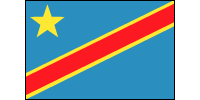| Country (long form) |
Democratic Republic of the Congo |
| Capital |
Kinshasa |
| Total Area |
905,567.86 sq mi
2,345,410.00 sq km
(slightly less than one-fourth the size of the US) |
| Population |
53,624,718 (July 2001 est.)
note: estimates for this country explicitly take into account the effects of excess mortality due to AIDS; this can result in lower life expectancy, higher infant mortality and death rates, lower population and growth rates, and changes in the distribution of population by age and sex than would otherwise be expected |
| Estimated Population in 2050 |
181,922,656 |
| Languages |
French (official), Lingala (a lingua franca trade language), Kingwana (a dialect of Kiswahili or Swahili), Kikongo, Tshiluba |
| Literacy |
77.3% total, 86.6% male, 67.7% female (1995 est.) |
| Religions |
Roman Catholic 50%, Protestant 20%, Kimbanguist 10%, Muslim 10%, other syncretic sects and indigenous beliefs 10% |
| Life Expectancy |
46.96 male, 50.98 female (2001 est.) |
| Government Type |
dictatorship; presumably undergoing a transition to representative government |
| Currency |
Congolese franc (CF) |
| GDP (per capita) |
$600 (2000 est.) |
| Industry |
mining (diamonds, copper, zinc), mineral processing, consumer products (including textiles, footwear, cigarettes, processed foods and beverages), cement |
| Agriculture |
coffee, sugar, palm oil, rubber, tea, quinine, cassava (tapioca), palm oil, bananas, root crops, corn, fruits; wood products |
| Arable Land |
3% |
| Natural Resources |
cobalt, copper, cadmium, petroleum, industrial and gem diamonds, gold, silver, zinc, manganese, tin, germanium, uranium, radium, bauxite, iron ore, coal, hydropower, timber |
|


|